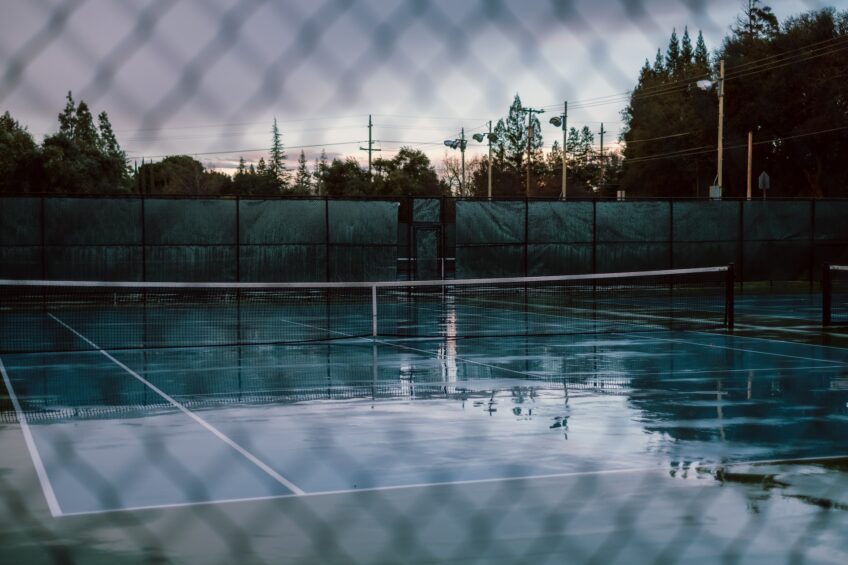Have you ever wondered what playing tennis in the rain would feel like? You may have heard that it’s not a good idea but is it true? Discover why it may not be a great idea and what precautions you should take when playing tennis in the rain. You’ll be armed with the knowledge to let you make an informed decision – So, let’s get started!
If you are a tennis enthusiast or simply someone who wants to try something new, it’s natural to wonder if you can play tennis in the rain. After all, rainy days can be a bit dreary and boring, and playing a sport outdoors is a great way to get some exercise and fresh air. Here, we will explore the topic of playing tennis in the rain. We will discuss whether it’s safe to do so, as well as any precautions that should be taken if you decide to go ahead and hit the court during a downpour.
The Benefits
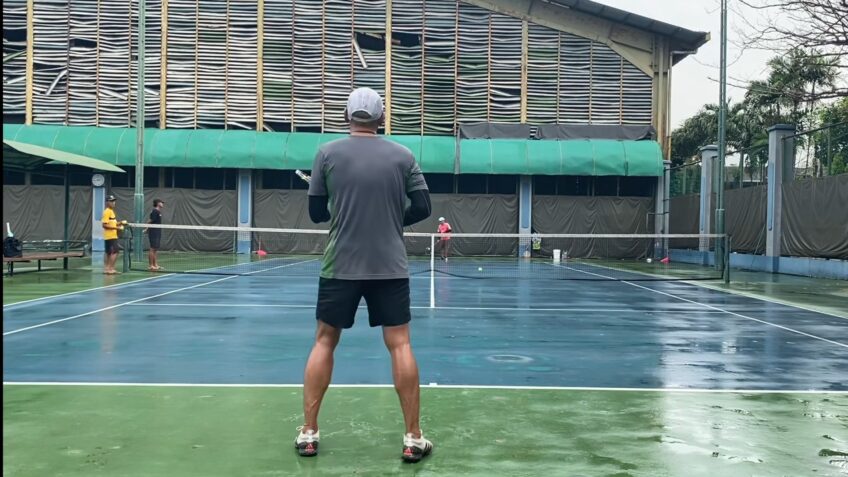
It offers a unique experience that can enhance your overall gameplay. Here are a few reasons why you might want to consider picking up your racquet and playing in wet conditions:
- Improved focus: Playing in inclement weather can help sharpen your concentration as you work to adapt to changing conditions.
- Better ball control: Wet surfaces make the ball slower and heavier, allowing for better accuracy and control during rallies.
- Enhanced endurance: The added challenge of playing in unfavorable weather conditions can help improve your stamina and overall fitness.
- Fun and exciting: Playing tennis in the rain offers a thrilling new experience that can make you feel more connected with nature.
More than just offering unique benefits, playing tennis on rainy days also provides an opportunity to become a more versatile player. By training yourself to play well under different weather conditions, you’ll be better equipped for any tournament or competition. During wet-weather play, it’s important to stay safe by taking care not to slip or trip on rain-slicked surfaces.
Additionally, wearing appropriate gear such as waterproof shoes, moisture-wicking clothing, and sweatbands can help prevent injury and maintain comfort throughout extended matches. In summary, while playing tennis in the rain may have its risks, it also offers numerous benefits that any enthusiastic tennis player shouldn’t miss out on. So next time there’s a downpour outside, don’t hesitate to grab your racquet and enjoy some wet-court fun!
The Risks
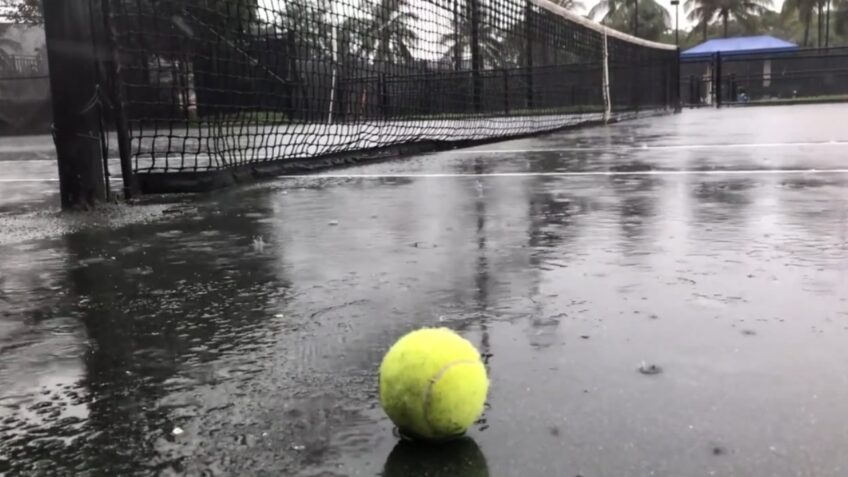
It can be quite risky as the rain can create a slippery surface on the court which can lead to slips and falls. Not only this but playing tennis in wet conditions can also increase your chances of getting injured as your feet and shoes become heavier due to water absorption. Moreover, playing in wet conditions can affect the quality of play as it becomes difficult to control the ball due to dampness.
The risks of playing tennis in the rain are not just limited to physical injuries. Playing in such weather conditions exposes you to other dangers like catching a cold or flu due to prolonged exposure to dampness. Wet clothes will make you cold which could mean you may not be able to enjoy your game which might irritate you. Additionally, keeping dry during a break between sets or after completing your match becomes quite difficult.
Playing tennis in the rain with a metal racquet is an even bigger risk that increases the likelihood of getting hit by lightning due to its conductivity resulting in electrical discharge optioning toward body strikes from lightning bolts.
Tips for Playing Tennis in the Rain
There are a few tips that can help you ensure that your game remains safe and enjoyable. Here are three steps to keep in mind:
| Step | Description |
| 1. | Wear appropriate clothing: One of the most important things you can do when playing tennis in the rain is to wear clothes that will keep you warm and dry. This means choosing waterproof shoes, a jacket with a hood, pants or shorts that won’t absorb water, and gloves if necessary. |
| 2. | Choose the right court: Not all tennis courts are created equal when it comes to playing in wet weather. Look for one with good drainage or opt for an indoor court if possible. |
| 3. | Adjust your gameplay: It could mean adjusting how you approach your shots and movement on the court. For example, footing may be more difficult on wet grass or clay courts, so adjust your movements accordingly. |
How to Stay Safe
It’s important to take precautions to stay safe. Here are some tips on how to do that:
- Choose non-slip and lightweight clothing that allows for a full range of motion. Avoid wearing anything too bulky or heavy as it can hinder your movement.
- Use the right shoes – Invest in tennis shoes with good traction and grip to prevent slipping on wet surfaces. Avoid running shoes or regular sneakers as they don’t provide enough support and grip.
- Stay hydrated – In wet conditions, it can be easy to forget about drinking water since you’re not sweating as much, but staying properly hydrated is essential for your safety and performance.
- Keep a towel nearby – Wipe down any wet spots on the court before playing to avoid slipping while playing.
- Monitor the weather – If there’s lightning or thunder, stop playing immediately and take shelter in a safe location until it passes.
When playing tennis in the rain, there are certain risks you need to be aware of. The most obvious risk is slipping and falling due to wet surfaces, which could result in serious injuries like sprains or fractures. Additionally, if you get too cold or too wet during play, you may suffer from hypothermia or other related conditions.
How to Minimize the Risks
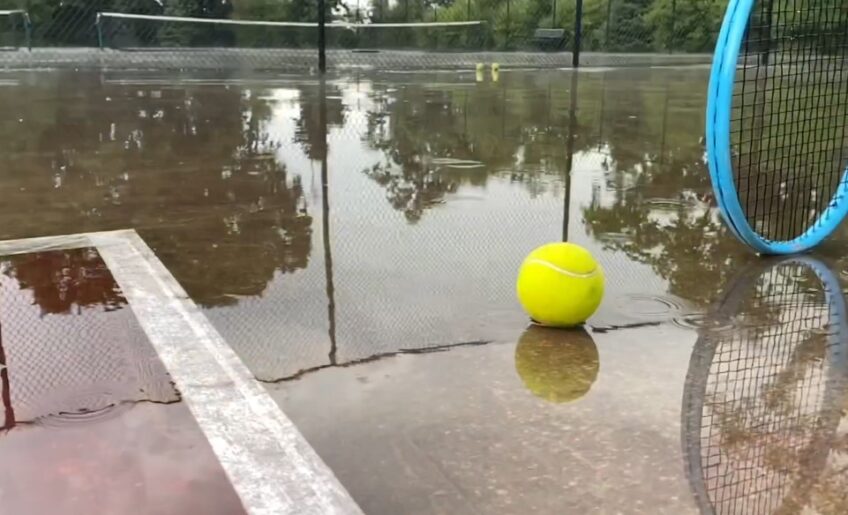
To minimize the risks, there are several precautions you can take.
- Wear appropriate clothing. Make sure your clothes and shoes are waterproof to keep yourself dry and prevent slips. Consider wearing a hat with a brim or visor to keep the rain out of your eyes.
- Choose the right court surface. Avoid clay courts as they become slippery when wet. Opt for hard or indoor courts if possible.
- Use grip-enhancing products. Apply an antiperspirant on your palms and add grip enhancers to the handle of your racket to improve control.
- Stay alert and aware of your surroundings. In wet conditions, it’s easy to lose focus and slip or trip over uneven ground or equipment left on the court.
Lastly, consider using a tennis ball specifically designed for use in wet conditions. These balls are heavier and have more felt than regular tennis balls for better control. To summarize, when playing tennis in the rain, take precautions such as wearing appropriate clothing and footwear, choosing the right court surface, using grip-enhancing products, staying alert and aware of your surroundings, and using tennis balls designed for wet conditions.
The Best Shoes for Playing Tennis in the Rain
When it comes to playing tennis in the rain, having the right footwear can make all the difference. Here are five points to consider when choosing the best shoes for playing tennis in wet conditions:
- Look for shoes with good traction – this will help prevent slipping on a wet court.
- Choose shoes with a waterproof or water-resistant upper. Make sure the shoes fit well and provide ample support for your feet and ankles.
- Consider wearing thicker socks to keep your feet warmer and drier.
- Opt for shoes with good ventilation to allow your feet to breathe and prevent overheating.
Playing tennis in wet conditions poses some unique challenges, but having the right shoes can help minimize those risks. With proper footwear, you can stay comfortable and focused on your game without worrying about slipping or getting soaked.
The Best Clothing Rainy Weather
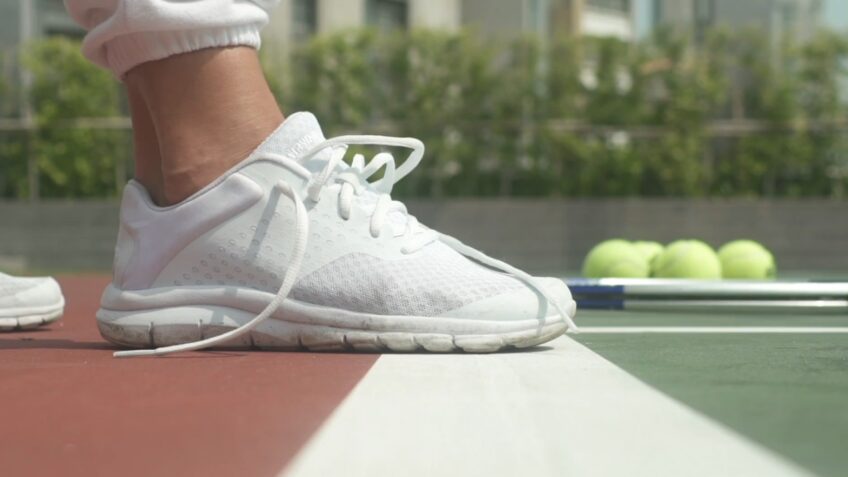
To play tennis comfortably in the rain, you need the right clothing that will keep you dry without hindering movement. Here are some of the best clothing options to consider:
- A water-resistant jacket: For protection against rain and wind, a water-resistant jacket is essential. Look for one with taped seams to keep water from seeping through.
- A moisture-wicking shirt: Wearing a cotton shirt can leave you feeling damp and uncomfortable. Opt for a moisture-wicking shirt that will keep sweat away from your body.
- Tennis shorts or leggings: Make sure your bottoms are also moisture-wicking and quick-drying. Avoid wearing cotton shorts that can leave you feeling heavy and weighed down.
- A hat or visor: To keep the rain out of your eyes, wear a hat or visor. Choose one with a brim that will also help protect your face from the elements.
- Headbands and wristbands: Wearing sweatbands can help absorb moisture, keeping it out of your eyes and off your hands during gameplay.
- Waterproof socks: Wet feet can quickly ruin your tennis game. Invest in waterproof socks to keep your feet dry even if you end up stepping in puddles.
Playing tennis in rainy weather doesn’t have to be uncomfortable if you’re dressed correctly. Remember to choose clothes made of moisture-wicking materials that can wick away sweat while keeping the rain at bay.
Choosing comfortable clothing is essential when playing tennis, but it’s especially important when playing in wet conditions. The right outfit should not only protect you from the elements but also allow for a full range of motion during gameplay. A water-resistant jacket is an absolute must-have as it protects against wind and rain to limit discomfort on the court. Coupled with moisture-wicking shirts and quick-drying shorts or leggings, you can be sure that your body won’t be weighed down during the game.
Make use of hats and visors that help protect your face from the elements and even come in handy in keeping the rain out of your eyes. Additionally, wearing sweatbands helps absorb sweat, keeping it out of your eyes and off your hands during crucial moments. Finally, waterproof socks are a game-changer when it comes to playing tennis in the rain as they keep feet dry even if you end up stepping in puddles. With these essential clothing items, playing tennis comfortably in the rain becomes less challenging and still fun.
FAQs
Is it okay to play in light rain?
It is generally not recommended to play in any type of rain, including light rain. The court can become slippery, making it unsafe to play.
Can I use a wet towel to dry my tennis balls?
No, it is not recommended to use a wet towel to dry your tennis balls. It’s better to replace them with dry ones to ensure proper play.
Should I cover the tennis court during the rain?
Covering the tennis court during rain can help protect the surface and keep it dry. However, this is not always feasible or practical for all courts.
Can I play with a different type of ball in the rain?
You can play with a different type of ball in the rain, such as a heavy-duty tennis ball that is designed for wet conditions. However, it’s important to check with your opponent and follow tournament rules.
What should I do if there is thunder and lightning during a tennis match in the rain?
If there is thunder and lightning during a tennis match in the rain, you should immediately stop playing and seek shelter indoors. It’s important to take safety precautions during thunderstorms.
Can I play tennis in the rain if it’s a tournament match?
It depends on the tournament rules and regulations. Some tournaments may allow play in the rain, while others may have specific guidelines for inclement weather.
Is there a time limit on when I should stop playing tennis in the rain?
There is no set time limit on when you should stop playing tennis in the rain. It’s best to use your judgment and assess the conditions to determine when it’s unsafe to continue playing.
Conclusion
Playing tennis in the rain can be challenging, but it isn’t impossible. However, there are some things you need to keep in mind if you want to play in the rain. It’s essential to have the right mindset and gear before you start your game. The first thing you need is a good pair of shoes with excellent traction. This will help prevent slips and allow you to move around the court comfortably. You should also wear waterproof clothing to keep yourself dry while playing in the rain.
Another important consideration when playing tennis in the rain is safety. Slick wet surfaces can pose a significant risk of injury, so it’s crucial to take extra caution while playing. Slow down your movements, and be alert for any slippery areas on the court. It’s also important to maintain your equipment properly when playing in the rain. Tennis racquets can become slippery when they get wet, so make sure you wipe them down often during gameplay. Similarly, tennis balls can become heavier when wet, which can affect their performance.

